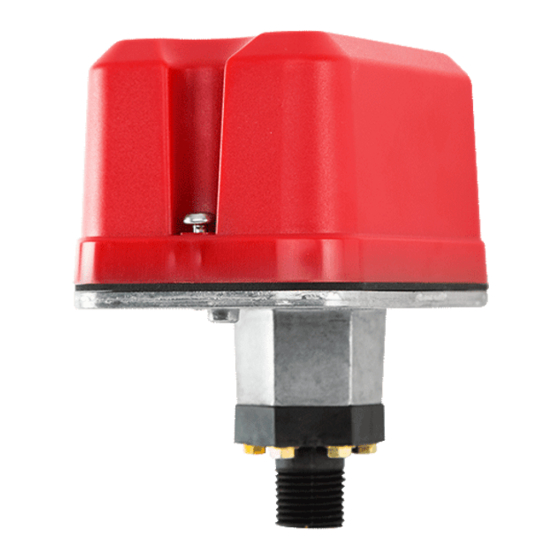Advertisement
Installation AND MAINTENANCE INSTRUCTIONS
EPS40 Series and EPS120 Series
Supervisory Pressure Switches
Specifications
Contact Ratings:
Overall Dimensions:
Operating Temperature Range:
Maximum Service Pressure:
Adjustment Range:
Enclosure Rating:
Approximate Differential:
Important
Please Read Carefully and Save
This instruction manual contains important information
about the installation and operation of supervisory pres-
sure switches. Purchasers who install switches for use by
others must leave this manual or a copy of it with the user.
Read all instructions carefully before installation, following
only those instructions that apply to the model you are in-
stalling.
Before installing any alarm device, be thoroughly familiar
with:
NFPA 72:
National Fire Alarm Code
NFPA 13:
Installation of Sprinkler Systems
NFPA 25:
Inspection, Testing, and Maintenance of Water-
based Fire Protection Systems
NFPA 13D: Standard for 1 and 2 Family Dwellings and
Manufactured Homes
NFPA 13R: Standard for Multi-family Dwellings
Other applicable NFPA standards, local codes, and the re-
quirements of the authority having jurisdiction.
Failure to follow these directions may result in failure of the
device to report an alarm condition. System Sensor is not
responsible for devices that have been improperly installed,
tested, or maintained.
D770-17-00
Technical Manuals Online! - http://www.tech-man.com
10 A, 1/2 HP @ 125/250 VAC
2.5A @ 6/12/24 VDC
See Figure 1
–40° F to +160° F
EPS40-1, EPS40-2:
250 PSI
EPS120-1, EPS120-2: 250 PSI
EPS40-1, EPS40-2:
10-100 PSI
EPS120-1, EPS120-2: 10-200 PSI
UL 4x — Indoor or Outdoor Use
NEMA 4 — Indoor or Outdoor Use
EPS40-1, EPS40-2:
3 PSI at 10 PSI
6 PSI at 100 PSI
EPS120-1, EPS120-2: 3 PSI at 10 PSI
9 PSI at 200 PSI
Do not use in potentially explosive atmospheres. Do not
Operation
As pressure changes, a diaphragm actuates 1 or 2 snap ac-
tion switches. The pressure switch actuation is determined
by adjustment settings.
Figure 1. Pressure switch basic dimensions:
5-1/8"
1
3825 Ohio Avenue, St. Charles, Illinois 60174
CAUTION
leave unused wires exposed.
4-1/4"
SWITCH #2
GROUND
SCREW
(GREEN)
LOCKING SCREW
A Division of Pittway
1-800-SENSOR2, FAX: 630-377-6495
HEX
ADJUSTMENT
SCREW
MAIN ADJUSTMENT
WHEEL
1/2" NPT
A78-2345-00
I56-986-02
Advertisement
Table of Contents

Summary of Contents for Pittway System Sensor EPS40 Series
- Page 1 INSTALLATION AND MAINTENANCE INSTRUCTIONS EPS40 Series and EPS120 Series A Division of Pittway 3825 Ohio Avenue, St. Charles, Illinois 60174 Supervisory Pressure Switches 1-800-SENSOR2, FAX: 630-377-6495 Specifications Contact Ratings: 10 A, 1/2 HP @ 125/250 VAC 2.5A @ 6/12/24 VDC...
- Page 2 Figure 2. Typical piping diagram for EPS40-1, Figure 3. Typical piping diagram for EPS120-1, EPS40-2 EPS120-2 WIRE TO SUPERVISORY WIRE TO ALARM EPS120EXP INDICATING CIRCUIT CIRCUIT OF FIRE ALARM PRESSURE CONTROL PANEL OF FIRE ALARM EPS40EXP EPS10EXP SUPPLY CONTROL PANEL SPRINKLER SYSTEM WATER...
- Page 3 Adjustments To Factory Settings Figure 5. Adjustments (Dual-switch model shown): SWITCH 2 Table 2. (LOW SWITCH SWITCH 1 EPS40-2 AND (HIGH SWITCH FACTORY SETTINGS (PSI) ADJUSTING EPS120-2) EPS40-2 AND EPS120-2; SCREW LOW SWITCH EPS40-1) MODEL 1/4" HEX HEAD Fall SW2 Nominal Rise SW1 (NOT PRESENT IN...
- Page 4 but not less than bi-monthly. • Install a back-up control for all critical applications where control failure could endanger life or property. A backup control to serve as a high or low limit con- trol is especially recommended for applications where a runaway condition could result.





Need help?
Do you have a question about the System Sensor EPS40 Series and is the answer not in the manual?
Questions and answers